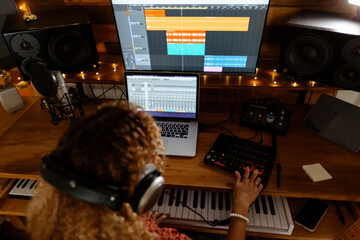Audio equipment plays a crucial role in delivering high-quality sound, whether for professional recording, home entertainment, live performances, or casual listening. The right tools allow individuals to experience music, voice, and sound effects with clarity, depth, and precision. Understanding the different types of audio equipment, their functions, and best practices for use ensures optimal performance and a richer listening experience.

The Importance of Audio Equipment
Sound is a fundamental part of human experience, influencing emotions, mood, and focus. High-quality audio equipment captures and reproduces sound accurately, making it essential for musicians, content creators, event organizers, and home enthusiasts. Poor audio quality can distort sound, reduce clarity, and diminish the enjoyment or effectiveness of any audio-related activity. Investing in appropriate audio tools ensures that every note, beat, and vocal nuance is delivered as intended.
Audio equipment is not just about loudness—it is about clarity, fidelity, and reliability. Well-maintained systems enhance experiences, whether in music production, live events, or everyday listening.
Core Types of Audio Equipment
Audio equipment spans several categories, each serving a unique purpose:
- Microphones: Capture sound from vocals, instruments, or ambient environments. Different types, such as dynamic, condenser, and ribbon microphones, are suited to various applications based on sensitivity and frequency response.
- Speakers and Monitors: Convert electrical signals into sound waves. Studio monitors provide accurate sound for recording and mixing, while home speakers enhance music and movie experiences.
- Mixing Consoles: Allow users to blend multiple audio sources, adjust levels, apply effects, and control outputs for live or recorded audio. Mixing consoles range from simple analog boards to advanced digital systems.
- Audio Interfaces: Serve as the bridge between instruments or microphones and recording devices, converting analog signals into digital formats for editing and production.
- Headphones: Provide detailed, private listening. Studio headphones are designed for accuracy, while consumer headphones focus on comfort and entertainment quality.
- Amplifiers: Boost audio signals to drive speakers efficiently, ensuring consistent volume and clarity.
- Cables and Accessories: High-quality cables, stands, pop filters, and shock mounts ensure reliable connections and protect equipment while enhancing performance.
Each component contributes to a complete audio system, and selecting the right combination is essential for optimal sound reproduction.
Choosing the Right Equipment
Selecting audio equipment depends on purpose, environment, and skill level. Beginners may prioritize ease of use and affordability, while professionals seek precision and reliability. Key considerations include:
- Intended Use: Recording, live performance, broadcasting, or casual listening requires different types of equipment.
- Sound Quality: Look for equipment with a clear, balanced frequency response and low distortion.
- Durability: Reliable construction ensures the equipment withstands frequent use or transport.
- Connectivity: Compatibility with existing devices and ease of setup are important.
- Budget: Determine the necessary features and balance cost with performance.
Understanding specific needs ensures that investment in audio equipment delivers the best results for the intended application.
Setting Up a Home Audio System
Home audio systems enhance entertainment experiences, whether for music, movies, or gaming. Key setup tips include:
- Speaker Placement: Position speakers to create an immersive soundstage and avoid reflections from walls.
- Room Acoustics: Soft furnishings, carpets, and curtains can reduce echoes and improve clarity.
- Cables and Connections: Use high-quality cables and connectors for clean signal transmission.
- Calibration: Adjust volume, equalizer settings, and speaker alignment for balanced audio.
Even a modest setup, when arranged thoughtfully, can transform ordinary listening into a rich, immersive experience.
Professional Audio Setup
Professional audio setups for studios, events, or broadcasts require careful planning and equipment selection. Considerations include:
- Signal Flow: Understand how audio travels from source to output, ensuring proper routing and minimal interference.
- Monitoring: Use accurate studio monitors and headphones to evaluate sound quality during recording and mixing.
- Acoustic Treatment: Optimize room acoustics to prevent unwanted echoes, reverberation, or frequency imbalance.
- Backup Systems: Have spare microphones, cables, and power sources to avoid disruptions during live events.
Professional setups emphasize reliability, precision, and flexibility to handle diverse audio challenges effectively.
Maintenance and Care
Proper maintenance extends the life of audio equipment and ensures consistent performance:
- Regular Cleaning: Remove dust and debris from microphones, speakers, and consoles.
- Safe Storage: Keep equipment in protective cases when not in use to prevent damage.
- Check Connections: Inspect cables and connectors regularly to prevent signal loss or interference.
- Avoid Overloading: Maintain appropriate levels to prevent distortion or damage to speakers and amplifiers.
Routine care ensures that audio systems remain functional, reliable, and capable of producing high-quality sound over time.
Advancements in Audio Technology
Modern audio technology has introduced innovations that improve sound quality and usability:
- Digital Audio Processing: Allows for precise control, effects, and editing during recording or live events.
- Wireless Systems: Reduce clutter and provide flexibility for stage performances or home setups.
- Smart Integration: Audio equipment can now connect with smart devices, streaming platforms, and home automation systems.
- High-Resolution Audio: Delivers richer, more detailed sound for critical listening.
Staying updated with technology ensures that audio enthusiasts and professionals can take advantage of improved capabilities and convenience.
The Role of Audio Equipment in Everyday Life
Audio equipment is not just for professionals—it enriches daily experiences for everyone. Clear, high-quality sound enhances music listening, video streaming, gaming, and virtual meetings. Good audio equipment allows people to engage fully with media, enjoy clearer communication, and experience immersive soundscapes.
Whether for personal enjoyment, educational purposes, or creative projects, the right audio tools significantly impact quality and enjoyment.
Audio equipment is essential for capturing, reproducing, and enhancing sound in both professional and personal contexts. From microphones and speakers to mixing consoles and headphones, each component plays a vital role in creating a complete and effective audio system.
Choosing the right equipment, setting it up properly, and maintaining it carefully ensures reliable performance, clear sound, and a satisfying listening experience. Whether for home entertainment, professional recording, or live events, investing in quality audio equipment enhances every aspect of sound and allows people to experience audio in its fullest form.